Each week we feature 7 artists from Art in Odd Places 2018: BODY NYC.
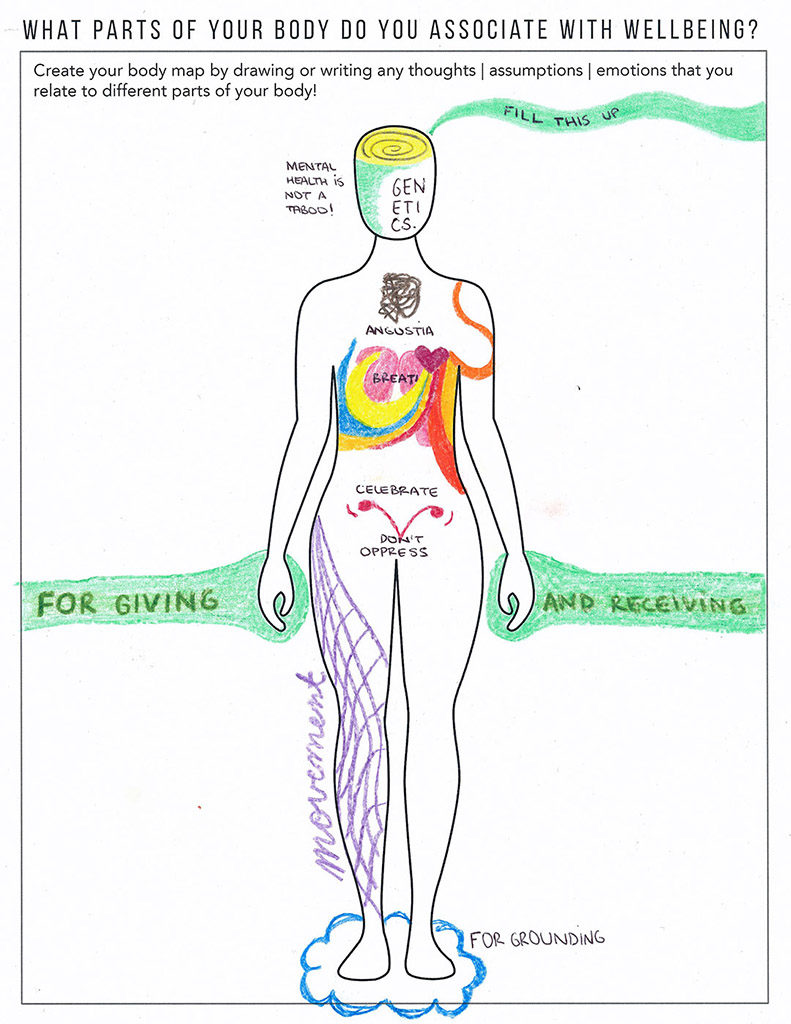
Daniela Mekler, Body Map, 2017
Daniela Mekler
1. Tell us about yourself and your project for AiOP BODY 2018:
I am an artist and educator committed to exploring the relationship between art, education, and community based activism. I am especially interested in looking at contemporary art as a site for critical exchange. The project, My Body is Not in Question, is an ongoing body of work that invites individuals to respectfully explore their well-being, sexual health, and reproductive rights through a series of visuals. This project began with a focus on self-identifying women, but I am striving to uplift all voices that haven’t always been invited to the table. The objective is to both encourage reflection that empowers participants to advocate for their needs in a society where their social power, rights, and privileges are not always considered and are at times dismissed, as well as to create empathy by inviting those with power to be an ally. The project will result in a community archive that can function as a resource to better understand people’s needs regarding reproductive well-being.
2. What does the theme BODY mean to you?
The theme of BODY, to me, represents a platform for coming together and fostering conversation; a vessel through which we can continue a dialogue around themes of community, agency, self, gender, politics, sex, exclusion, language.
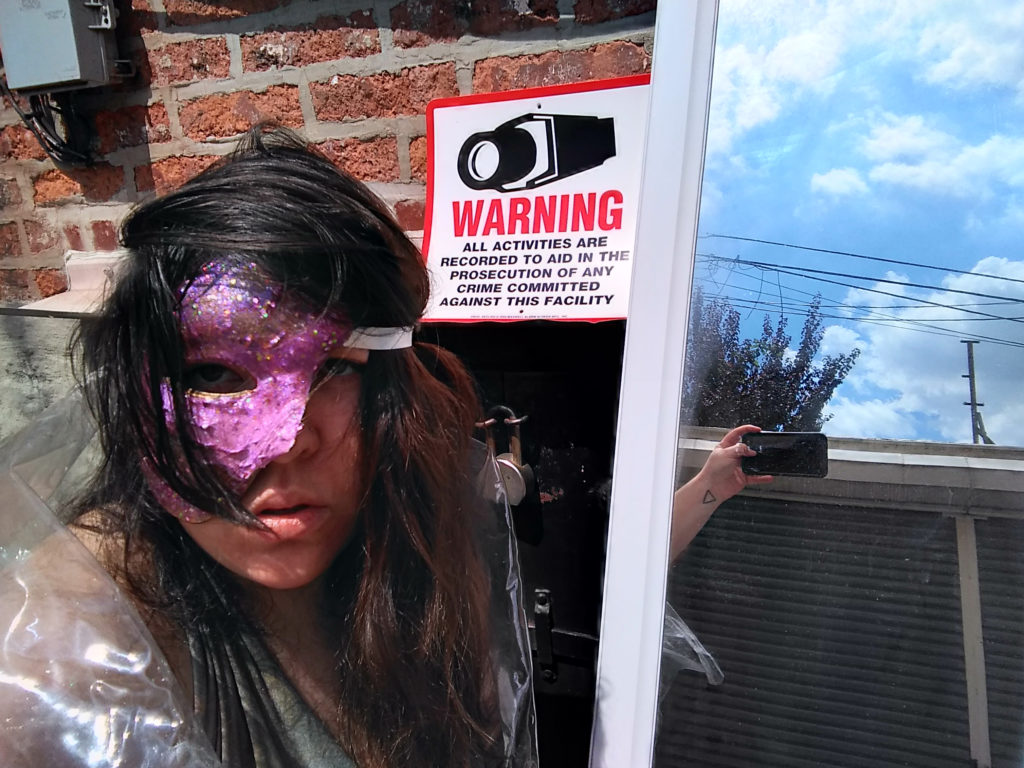
Sierra Ortega, [you]phoria, 2018. Photo Credit: Sierra Ortega
Sierra Ortega
1. Tell us about yourself and your project for AiOP BODY 2018:
Through disruptive, durational practices that are generated from my lived experience as an anxious bipolar, my work invites the audience to look upon the foundations of exploitation, incarceration, and medical-ization of neuro-queer bodies within late-capitalism. This work uses the DSM criteria for Body & Gender Dysphoria as an inspiration. I respond to a pulse, just here, in my hip joint to transform myself into a visible invisible body. An aching queer body. My world is a mirror, of infinite depth. I am overwhelmed by the narcissistic impulse that emerges from the abject; to confront the “me that is not me”, to make my body, in its perceived monstrosity, an object of reflective desire, to emerge as a figure of surreal grace. My body will map the space of 14th St. with new topographies reflective of itself; alternative articulations.
2. What does the theme BODY mean to you?
This year’s theme of BODY for me is an invitation to make visible bodies in all their varied forms and habits. A revelation (and revolution) of shape, texture, color, energy, sensuality, etc. of all the individual and collective bodies that find themselves entangled within the flux of existence.

Joanne Leah, Reproduction of the Mouth, 2016. Photo Credit: Joanne Leah
Joanne Leah
1. Tell us about yourself and your project for AiOP BODY 2018:
Joanne Leah creates images that portray a series of contorted nude body parts with ordinary, yet highly stylized props. Using color as her narrative, she takes the viewer on an eerie trip through staged, fairytale crime scenes. She draws from her own personal experiences with fetish and acts of psychedelic voyeurism. Exploring themes of sexuality, isolation and identity, she challenges the viewer to react to the human form and the tactile quality of fluids and fleshiness.
‘Shock Corridor’ juxtaposes images of nude bodies and constructions sites, metaphorically bringing the concept of “female” from the traditional private, home-bound role in society to an extremely public and masculine space. The project uses existing green construction panels as part of the installation. The artwork exists in two contexts, yet refers to one place simultaneously. The second, private context will be video footage of the public’s reaction and displayed in Westbeth Gallery.
2. What does the theme BODY mean to you?
The body is evidence of a gesture and a beautiful monotonous prison.
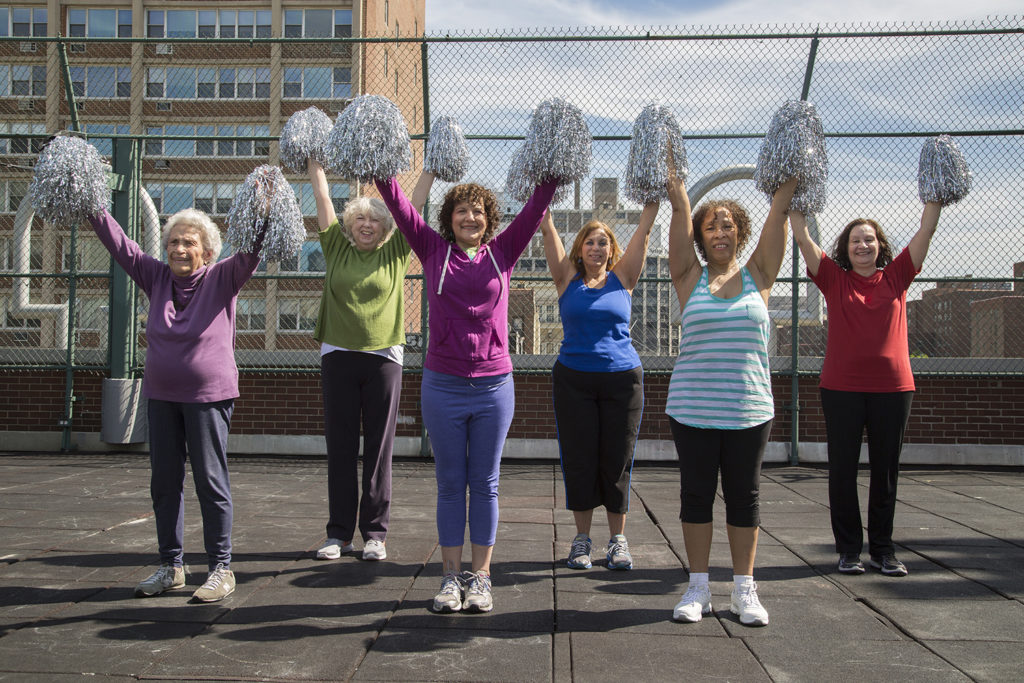
Laura Nova, Silver Sirens, 2017. Photo Credit: Laura Nova
Laura Nova: Silver Sirens
1. Tell us about yourself and your project for AiOP BODY 2018:
Artist, Athlete, Activator and Long-time Lower East Side resident, I generate site-specific, action-oriented projects which invite participatory energies of neighbors and strangers alike. I coach the Silver Sirens, a cheerleading squad of senior citizens, in a weekly writing and movement workshop with choreographer Julie Gayer Kris, the Director of Member Engagement and teacher of yoga, dance and movement for all ages at the 14th Street Y. Combining advocacy and physical movement to increase wellness, participants champion issues that face their community in the East Village. We will perform in front of the 14th Street Y during the AiOP festival, engage the public in writing cheers, publish a field guide to cheerleading about healthcare that will be seen as a public banner and shared in print with a cheerleading video at the Westbeth Gallery.
2. What does the theme BODY mean to you?
I use physical movement to respond to public place as a shared stage for equitable social interaction. I exercise the body to practice gestures that empower us to act. These choreographed movements provide an act of resistance while maintaining a peaceful demonstration of mindful body restraint.
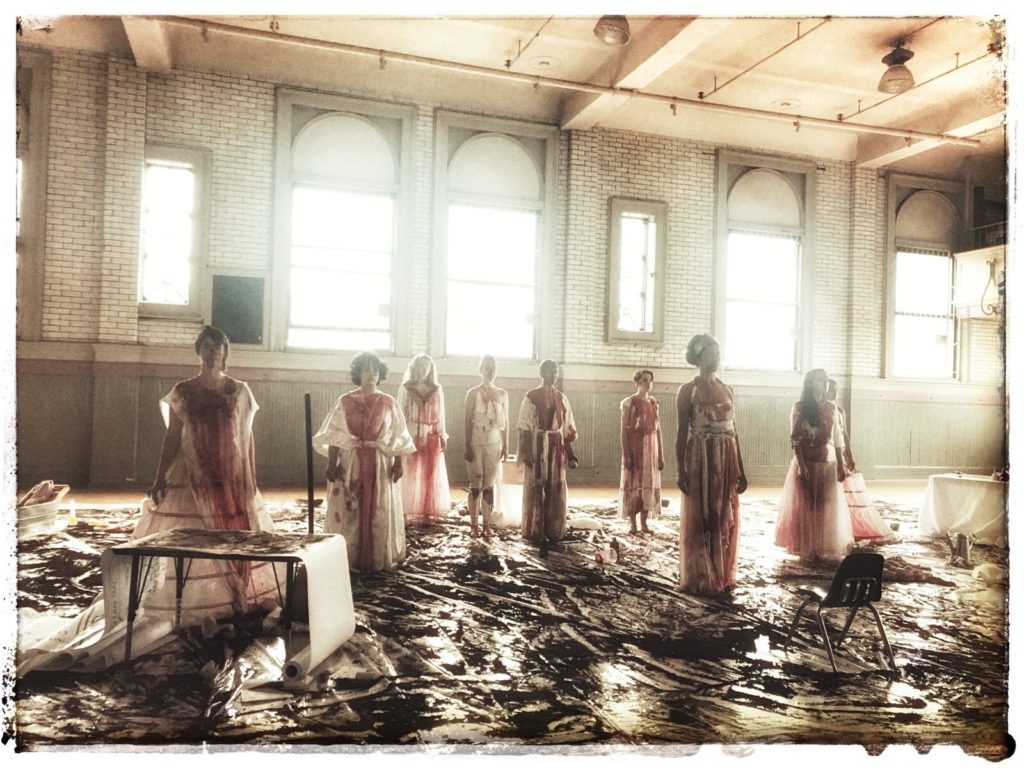
The DoMystics, Blood and Soil: The Art of Survival, 2018. Photo Credit: Selene Castilla
Monique Blom and Arantxa Araujo: The DoMystics
1. Tell us about yourself and your project for AiOP BODY 2018:
The DoMystics is a feminist collective created by Monique Blom and Arantxa Araujo based in NYC, Mexico City and Canada. The collective explores themes through ritual processes of identity, gender, immigration and domesticity. The work has been performed in the United States, Canada and Mexico.
“Unfolding” will focus on the idea of presence – the female body being in space – a ritual performance exploring the idea of wholeness. We purpose to personify invisibility/visibility, entirety/incompleteness and sufficiency/inadequacy of women as myth creators and caretakers of the world that surrounds us.
This durational piece will take place along 14th St. exploring the survival mechanism of BEING women and the daily task of BEING enough. We will embody existence without letting our daily tasks define who we are as women. We will give and receive using our bodies- multiplying/UNFOLDING to uncover the maintenance required in simply BEING.
2. What does the theme BODY mean to you?
BODY is a mechanism of maintenance. Our bodies are our means to be rooted in the present. It is through our ability to embody the practice of “being” that we bring light to women’s history, reality, and plausible futures. Through an emBODIED practice we look at time, space and womanhood.
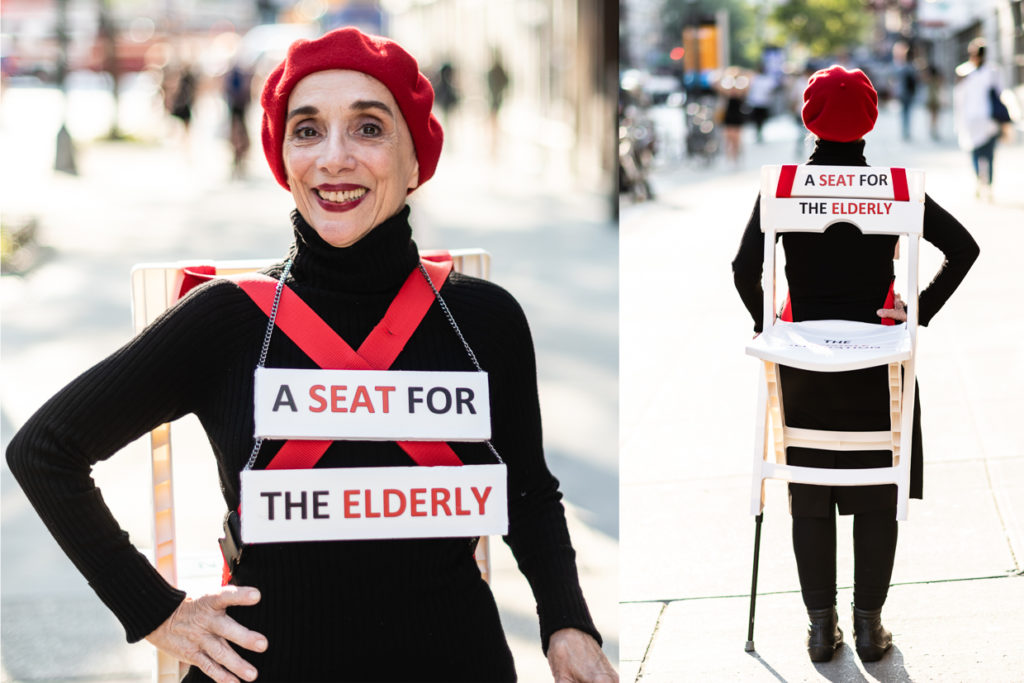
LuLu LoLo, A Seat For the Elderly, 2018. Photo Credit: Paul Takeuchi. www.paultakeuchi.com. Costume and Prop Design: Ramona Ponce. www.ramonaponce.com
LuLu LoLo
1. Tell us about yourself and your project for AiOP BODY 2018:
I am honored and exhilarated to be performing in my sixth AiOP Performance “BODY” with powerful women, female identifying and non-binary artists.
As a socially engaged performance artist I transform into different personas, inviting the public to experience an unexpected moment of intimacy, memory, compassion, generosity, and a call for social action in the midst of the technological cocoon we live in today.
“A Seat For The Elderly: The Invisible Generation” highlights the lack of compassion, even to the point of indifference, to the “invisible generation”–the elderly struggling with the fragility of their aging body. Focusing on this fragility, I will walk with a chair strapped to my back offering this “Seat For The Elderly” whom I encounter along 14th Street. Through this performance I will engage and challenge the public about the indifference and impatience that is shown to the elderly as they slowly make their way in the city.
2. What does the theme BODY mean to you?
A woman’s body goes through many life changes: childhood innocence, puberty, sexuality, maternity, menopause, and aging. I am highlighting the burden of aging by carrying a chair for the elderly strapped to my body showing the power and strength of women who take charge of their lives.
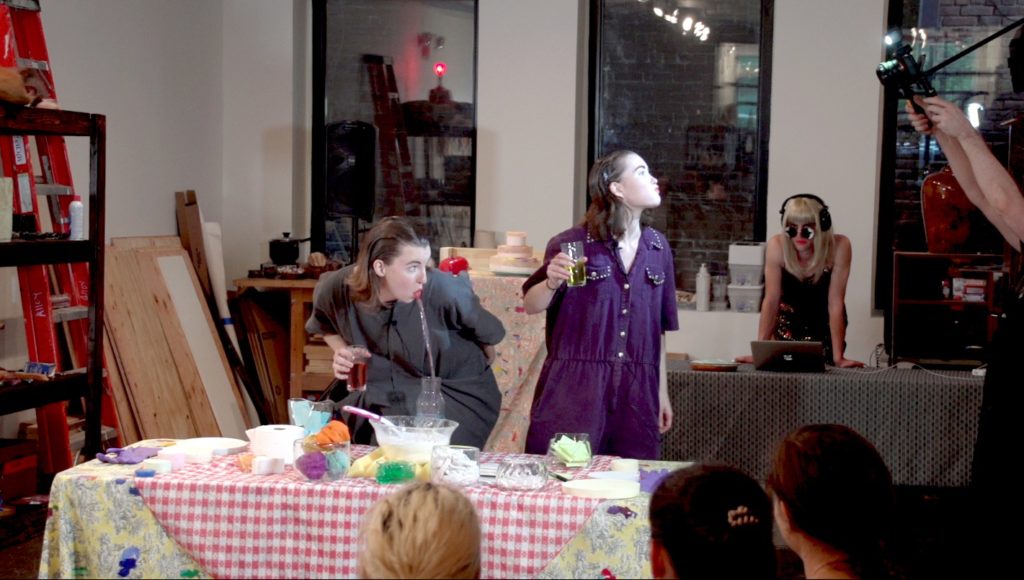
Grace Whiteside, Stacy Makes A Cake, 2018.Video Credit: Jonah King
Grace Whiteside: The Stacys
1. Tell us about yourself and your project for AiOP BODY 2018:
I am an interdisciplinary artist living and working in NYC. Within my work, I have become fascinated with alternative ways to navigate the idea of the home, and how home improvement is geared toward the reflection of one’s self and one’s quantifiable worth within a heteronormative, consumerist society.
“The Family Plan” is a two-part work about female identity and self-confrontation. The first part is a film trailer and installation that deals with my alter ego, Stacy Wallman’s, exploration of womanhood and sexuality throughout the confines of domesticity. These ideas continue throughout a series of performances at various consumer-centric locations along 14th street. Viewers will pass by a simulation of a childhood lemonade stand. Queer and female identifying performers (The Stacys) will be demonstrating absurd lemonade mixing techniques and serving up strange food substances. The film in conjunction with the performance will create a unified, albeit bizarre, experience.
2. What does the theme BODY mean to you?
My alter ego and the main character of this work, Stacy Wallman, acts as a surrogate for my own body and experiences. I am concerned with what it means to be a queer body in domestic parameters as well as in public space and how we orient otherness in the face of heteronormative environments.

